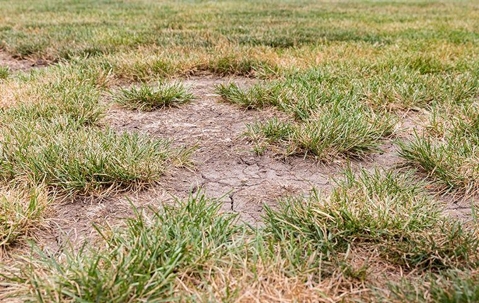At Turf Tactics, LLC, we are your experts for all things lawn maintenance in Spring Hill. In this guide, we’ll take a deeper look at different diseases and fungi affecting homes in our area and how you can protect your yard against them. Read on to learn more about lawncare spraying in Spring Hill.
How To Identify Common Types Of Lawn Disease
Some of the most common lawn diseases around Spring Hill include:
- Brown patch
- Fairy ring
- Dollar spot
- Rust fungus
- Gray leaf spot
Brown patch is one of the most common lawn diseases in our region. Brown patch is a fungus that spreads from spores in the grass that can grow up to several feet in diameter, leaving huge unsightly patches across your lawn. Brown patch can also manifest as circles of dead grass. Brown patch is generally caused by the lawn being over-watered, which is partly why it is more common in the fall.
Fairy rings are circles of abnormal turf growth that form on your lawn in rings that span anywhere from three to 20 feet in diameter. Occasionally, mushrooms will appear in a circle or semicircle. Fairy ring both saps your lawn’s root structure of nitrogen and produces mycelium, which prevents water from getting to the roots. Fairy rings are most common during the hot days of the year after heavy rainfall, but the disease itself is notoriously difficult to eliminate. It is slow-growing, so you may not realize you have it until years down the road, but once established, it is difficult to remove for good.
Dollar spot is another fungus that affects grass by leaving light brown dead patches in the leaves. These spots grow and lighten over time, leaving your lawn covered with irregular patches of light yellow, straw-colored grass. When dollar spot is already present, you may see white cobweb-like growth appear in the morning dew. It is most common in the warmer months, from May to October. Dollar spot is often caused or exacerbated by moisture stress as a result of overwatering or mowing too infrequently.
Rust disease turns lawns orange, yellow, or brown through the gradual growth of spore masses on the exterior of the leaf, giving them a rusty appearance. Insects can spread rust fungus, but like other fungi, commonly, overwatering causes it. Rust is most common in the spring and fall, affecting shaded grass that has been overwatered and left humid overnight.
As its name suggests, gray leaf appears in lawns as round or oval-shaped patches of gray surrounded by a dark brown border. These patches are typically four to 12 inches in diameter and may initially appear as yellow or orange. Under high humidity, the affected area can grow fuzzy due to excessive spore production.
How Lawn Diseases Start And Spread
Lawn diseases can develop for a number of reasons. Some of the most common include:
- Over-watering
- Under-watering
- Cutting the grass too short
- Improper fertilization practices
- Stress to the grass
Seasonality also has an impact on lawn disease and fungus development. As the seasons change, watering has a different impact on the lawn and needs to be carefully balanced to give the lawn just the right amount of water it needs based on the amount of sunlight it’s getting. While it never gets as cold in Spring Hill as in other parts of the country, cooler weather can still impact your lawn by reducing the rate at which water evaporates off it. If you water your lawn in November with the same frequency you did in June, your lawn won’t get enough sunlight to soak up all that moisture, and it can become a hotbed for fungi and bacteria to develop.
Lawn Diseases Will Not Just Go Away On Their Own
The problem with lawn fungi and diseases is that once established, they won’t go away on their own. If you have a fungus growing on your lawn, it will only grow worse until you take steps to stop lawn disease at its source.
Many homeowners see brown patches on their lawns and immediately think that they need to start watering those areas more, when in fact, the opposite is true. Once a disease or fungus has become established on your lawn, the last thing you want to do is give it more water; you need to eliminate it for good.
Contact The Experts To Tackle Your Lawn Disease
When it comes to creating a happy lawn in Spring Hill, the challenge is to strike the delicate balance of giving your lawn exactly what it needs when it needs it; this is a comparable challenge for many homeowners without access to the skills and tools that a professional lawn care provider can supply.
If you’re a Spring Hill homeowner worried about lawn diseases, worry no longer. Contact us here at Turf Tactics, LLC, for professional lawn maintenance. Our comprehensive treatment programs can keep your lawn looking green and healthy for years to come. Contact us today for details!

